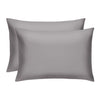The Daily Miracle
The 8 Best Ways To Sleep on Your Side
Published
July 08, 2024
Author
Bridget Reed

Are you waking up with neck pain or lower back pain? Do you feel like you didn’t get a good night’s sleep, even after hitting the snooze button a few times? The way you sleep can have a huge impact on your overall health and wellness.
If you’re a side sleeper, you’re in good company! Sleeping on your side is one of the most popular sleep positions and comes with many benefits.
Let’s explore the best ways to optimize your side sleeping position, covering everything from the ideal bedding materials (bamboo vs cotton sheets) to the importance of a body pillow for maintaining a neutral position.
Whether you’re trying to reduce bloating and constipation or just looking for relief from discomfort, these tips will guide you toward a more restful night's sleep.
What Are the Benefits of Sleeping on Your Side?
Sleeping on your side, whether it's your left side or right side, can improve your overall wellness, and not just because better sleep offers tons of benefits for your quality of life.
This sleep position helps reduce snoring, alleviate back discomfort, and promote better blood flow. Left-side sleeping is particularly beneficial for pregnant women, as it can improve circulation to the heart and reduce acid reflux. Plus, side sleeping can help prevent obstructive sleep apnea by keeping your airways open.
However, side sleeping isn't without its challenges. It can sometimes cause shoulder pain or hip pain due to pressure points. That's why it's important to have the right setup to ensure proper alignment and comfort throughout the night.
Best Ways To Optimize Side Sleeping
1. Choose the Right Mattress
The best mattress for side sleepers provides a balance of support and comfort. A medium-firm mattress is ideal because it supports your body’s natural curves while relieving pressure points, which is essential for reducing lower back pain and hip pain.
Memory foam mattresses are particularly good because they contour to your body, providing customized support and reducing pressure on your hips and shoulders. For those with health conditions such as sleep apnea or gastroesophageal reflux disease, a well-chosen mattress can improve sleep quality significantly.
2. Use the Right Pillow
The best pillow for side sleepers is one that supports your neck and keeps your spine in a neutral position, which is crucial for preventing neck pain and shoulder pain. A thicker pillow can help maintain proper alignment by filling the space between your shoulder and head.
Our luxury pillowcases can further enhance your sleep experience by regulating temperature and reducing bacteria growth. These pillowcases also require less frequent washing, making them a convenient choice for maintaining a clean and healthy sleep environment.
3. Maintain Proper Body Alignment
Keeping your spine aligned is crucial for reducing pain and improving sleep quality. Use a body pillow to support your torso and keep your spine straight.
Placing a pillow between your knees can also help maintain spinal alignment and reduce pressure on your hips and lower back, which is essential for preventing lower back pain and hip pain. Proper alignment not only provides pain relief but also helps in preventing sleep disorders like obstructive sleep apnea.
For pregnant women, maintaining correct alignment can significantly enhance comfort and support overall health during sleep. Achieving proper alignment ensures a restful and rejuvenating sleep experience.
4. Opt for the Right Bedding
Bedding plays a big role in sleep quality. Simple things like bamboo vs cotton sheets are common discussions, but there’s more to choosing the right bedding than that. You also have to think about things like your comforter and how it impacts your sleep temperature, regardless of your sleep position.
If you want a comforter that offers luxurious comfort and thermoregulation to make getting comfortable even easier after finding the best sleeping position for you, we’ve got you covered. Our Miracle Made® Comforter is also infused with silver to prevent up to 99.7% bacteria growth, which is beneficial for those with sensitive skin or allergies, too.
5. Sleep on Your Left Side
Sleeping on your left side can do wonders for your health and comfort. It’s great for reducing acid reflux and heartburn, especially if you suffer from gastroesophageal reflux disease (GERD). Left-side sleeping also helps with blood flow and is ideal for pregnant women because it improves circulation.
Plus, this position can keep your spine in a neutral position, which helps prevent lower back pain and reduces pressure points that cause shoulder pain and neck pain.
6. Use a Body Pillow
A body pillow is a side sleeper’s best friend. Hugging a body pillow helps keep your spine aligned, which can reduce lower back pain, hip pain, and shoulder pain.
It also supports your torso and helps you maintain a good sleep posture. This can be especially helpful if you’re pregnant, as it eases pressure on your back and belly.
If you have sleep apnea, a body pillow can help keep your airways open and reduce snoring. Using a body pillow ensures you stay in a comfy, neutral position all night, leading to better sleep quality and less pain when you wake up.
7. Avoid Stomach Sleeping
Stomach sleeping isn’t great for your body. It can cause neck pain, lower back pain, and spinal alignment issues. This position forces your spine into an awkward angle, increasing the chance of discomfort. It can also put pressure on your internal organs, leading to bloating and constipation.
If you’re a side sleeper, it’s important to avoid rolling onto your stomach during the night. By sticking to side sleeping, you’ll reduce the risk of pain and improve your sleep quality.
8. Elevate Your Head and Upper Body
Elevating your head and upper body can make a big difference for side sleepers, especially if you have sleep apnea, acid reflux, or heartburn. Propping yourself up with pillows or an adjustable bed can help keep your airways open, reducing snoring and making breathing easier. Elevating your upper body also keeps stomach acid down, which helps with acid reflux and heartburn.
It can also help with neck and shoulder pain by maintaining a neutral position and reducing strain. To get the best results, use a thicker pillow or an adjustable pillow to find the perfect height for you. This simple change can lead to better sleep and less discomfort, helping you wake up feeling refreshed and ready for the day.
The Bottom Line
Sleeping on your side can greatly improve your sleep quality. You can reduce issues like lower back, neck, and shoulder pain by choosing the right mattress and pillow, maintaining proper body alignment, and avoiding stomach sleeping. Elevating your head and upper body can help with sleep apnea and acid reflux, making breathing easier and reducing snoring.
Incorporating simple tools like a body pillow can keep your spine aligned and support your sleep posture. Whether you prefer left-side or right-side sleeping, following these tips can lead to a more restful and rejuvenating night's sleep.
These small changes in your sleep habits and environment can make a big difference. So, invest in the right bedding, prioritize your comfort, and enjoy the benefits of a good night's sleep every night!
Sources:
Good Sleep for Good Health | News in Health
Good Sleeping Posture Helps Your Back | University of Rochester Medical Center


























